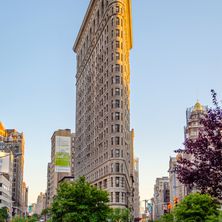

The Flatiron Building at 175 Fifth Avenue is perhaps the most beloved skyscraper in New York City. It is not as world-famous as the Empire State Building, nor is it as striking as other skyscrapers, especially ones that were erected at the end of the 20th century. But it is definitely the most enigmatic and original one.
The building takes its name from its particular shape, that of a clothes iron. Its single northern corner faces 23rd Street, while its eastern side stretches along Broadway, its western side along Fifth Avenue and its southern side along 22nd Street. The building forms a perfect triangle and the block on which it stands, therefore, is also triangular.
The 22-floor building was commissioned by the Fuller Company architectural firm and subsequently became its new headquarters. It was constructed in 1902 and in the period after its completion was known as the Fuller Building. Thanks to recently passed building codes, construction had only taken one year. At that time it was one of the highest structures in New York and the first skyscraper in the part of Manhattan north of 14th Street. It was designed in the Renaissance Revival style and was built with a mixture of limestone at the bottom and glazed terracotta towards the top. The prow, or rather the northern corner of the building where the eastern and western sides meet, is only two meters wide. If viewed from above, the prow presents an angle of approximately twenty-five degrees. It is so narrow that people passing under the skyscraper often wonder how anyone can possibly work there - the space is literally big enough for one desk.
Although public opinion was very positive when the Flatiron was constructed, architectural critics were not as enthusiastic. Many called it awkward and unimpressive, and believed that its shape, rather than being a sign of originality, on the contrary only showed the architect's lack of imagination, because essentially the building just conformed to the shape of the city block. The New York Tribune newspaper wrote that it was, "A stingy piece of pie; the greatest inanimate troublemaker in New York." The New York Times said that it was a "monstrosity." While the highbrow Municipal Art Society declared that it was "unfit to be in the center of the city" and conservative sculptor William Ordway Partridge was utterly disgusted, saying that it was "a disgrace to our city, an outrage to our sense of the artistic and a menace to life." Perhaps Partridge's opinion was conditioned by the fact that soon after the construction of the skyscraper, the streets surrounding it became infested with prostitutes, especially male prostitutes.
Nevertheless, ordinary New Yorkers were raving about the building. And not only ordinary citizens, but important artists and intellectuals, such as painters John Sloan and Everett Schinn, photographers Alfred Stieglitz and Edward Steichen and poet Carl Sadakichi Hartman. In fact, Hartman wrote several essays to accompany Stieglitz's photos promoting the aesthetic nature of the Flatiron.
But the most famous photograph of the building belongs to Steichen, one of America's greatest photographers. It was taken from Madison Square Park across the street, in 1904. It shows the strange, even ominous, building standing in the distance, enveloped by the foggy twilight. Three coachmen with top hats sit astride their carriages and a branch extending from a tree out of the frame cuts the building right through the middle. It is an eerie photograph, capturing the potential mystery behind Manhattan's most recent (back then) architectural wonder.
In the 20th century the Flatiron passed through the hands of many owners. Today its major shareholder is the Italian real estate developing firm Sorgente Group. The firm eventually wants to turn the office building into a luxury hotel. However, it will have to wait a few years until the leases of the current tenants expire. And some of those tenants are prestigious international companies, such as the Georg von Holtzbrinck Publishing Group, whose branches Macmillan, St. Martin's Press, Picador and Henry Holt & Company are all located in the building.
The Flatiron's prow has by now made the building a celebrity. It can be found on posters, postcards, T-shirts, mugs and practically any other souvenir available in New York. And unlike other major skyscrapers, due to its unordinary shape and solitary position, it can be observed from various interesting angles, which makes it a captivating model, both for professional and amateur camera lenses.